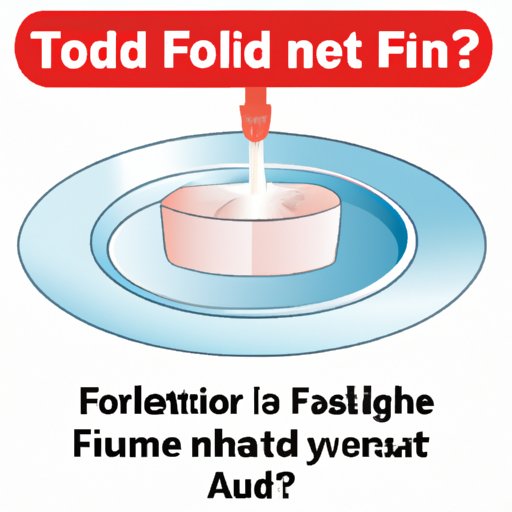
Introduction
Fluoride treatment is a popular dental procedure that helps prevent tooth decay and strengthens teeth. After undergoing fluoride treatment, it’s essential to follow proper aftercare guidelines to optimize the benefits. In this article, we’ll explore when you can eat after fluoride treatment, the foods to avoid, and essential considerations to ensure optimal oral health.
Understanding Fluoride Treatment: What You Need to Know Before Your Next Meal
Fluoride treatment involves the application of fluoride to the teeth to strengthen them and prevent tooth decay. The fluoride is typically applied in a variety of forms, including gels, foams, varnishes, or mouthwashes. The procedure is painless and typically takes a few minutes to complete.
Fluoride has been proven to be one of the most effective ways to prevent tooth decay. It works by strengthening the protective outer layer of the teeth called enamel. In addition, fluoride helps to reduce bacteria in the mouth that can lead to decay.
During treatment, your dental professional will apply the fluoride to your teeth using a brush or cotton swab. The fluoride will remain on your teeth for a few minutes before being rinsed off with water.
Eating After Fluoride Treatment: A Guide to Timing and Foods to Avoid
After fluoride treatment, it’s essential to wait for a reasonable amount of time before consuming anything. This will allow the fluoride to remain on your teeth and strengthen them effectively. Avoid rinsing your mouth or drinking anything for at least thirty minutes after treatment.
It’s also essential to avoid certain foods immediately after fluoride treatment. Foods high in acid and sugar can weaken teeth and counteract the effects of fluoride. Avoid any acidic or sugary foods such as fruits, juices, soda, or candy for at least two hours after treatment.
Instead, choose foods that are safe to consume after treatment, such as water, milk, cheese, and plain yogurt. These foods can also help neutralize any acids that may be present in your mouth, promoting oral health.
How Long Should You Wait to Eat and Drink After Fluoride Treatment?
The duration you should wait before eating or drinking after fluoride treatment will depend on the type of treatment you received. It’s essential to follow the instructions given by your dental professional diligently.
After treatment with fluoride varnish, it’s best to avoid eating or drinking anything for at least 4 to 6 hours. You can drink water after the first hour, but it’s best to avoid other drinks or foods. After treatment with fluoride gel or foam, wait at least 30 minutes before eating or drinking anything.
After treatment, it’s essential to rinse your mouth with water thoroughly. This will remove any excess fluoride and reduce the risk of ingestion, which can lead to flu-like symptoms.
Managing Your Post-Fluoride Treatment Diet: Tips for a Comfortable Recovery
After fluoride treatment, it’s common to experience sensitivity or irritation in your mouth. To ease any discomfort, try sipping on cool water or sucking on an ice cube. Avoid hot or cold foods, as they can exacerbate sensitivity.
It’s also essential to stay hydrated to promote optimal oral health. Drinking water, herbal tea, and warm broth can help soothe any irritation and prevent dry mouth.
Balancing Your Nutrition After Fluoride Treatment: Meal Ideas and Recipe Suggestions
After fluoride treatment, it’s essential to eat a balanced diet rich in nutrients that promote oral health. Some of the best foods to include in your post-treatment meal plan include whole grains, lean protein, fruits, vegetables, and low-fat dairy products.
Some meal ideas include a chicken salad with a side of steamed vegetables, a veggie wrap filled with hummus and avocado, or a turkey burger with sweet potato fries. For optimal oral health, be sure to include foods rich in calcium, vitamin D, and vitamin C.
The Impact of Food on Fluoride Treatment: How to Optimize Your Oral Health
The food you eat can significantly impact the effectiveness of fluoride treatment. Consuming a diet high in sugar, carbohydrates, or acid can weaken the protective layer of your teeth and counteract the benefits of fluoride.
On the other hand, certain foods can enhance the effectiveness of fluoride treatment. Foods rich in minerals, such as calcium, phosphorus, and magnesium, can help rebuild enamel and prevent tooth decay. Some of the best foods to include in your diet include leafy greens, nuts, seeds, and dairy products.
The Dos and Don’ts of Eating After Your Fluoride Treatment: Expert Advice and Common Questions Answered
Consult with your dental professional to determine the appropriate post-treatment guidelines to follow. Some common questions about eating after fluoride treatment include:
- How long should you avoid certain foods after treatment?
- Are there any foods you should avoid altogether?
- What can you eat to ease any sensitivity or discomfort?
- How can you optimize nutrition to support oral health?
Your dental professional can provide expert advice and answer any additional concerns or questions you may have.
Conclusion
Following proper aftercare guidelines after fluoride treatment can help optimize the benefits and promote optimal oral health. Wait at least 30 minutes after treatment before consuming anything, avoid sugary and acidic foods, and choose foods that support oral health. Consult with your dental professional for expert advice and additional recommendations to ensure a smooth recovery and optimal oral health.




